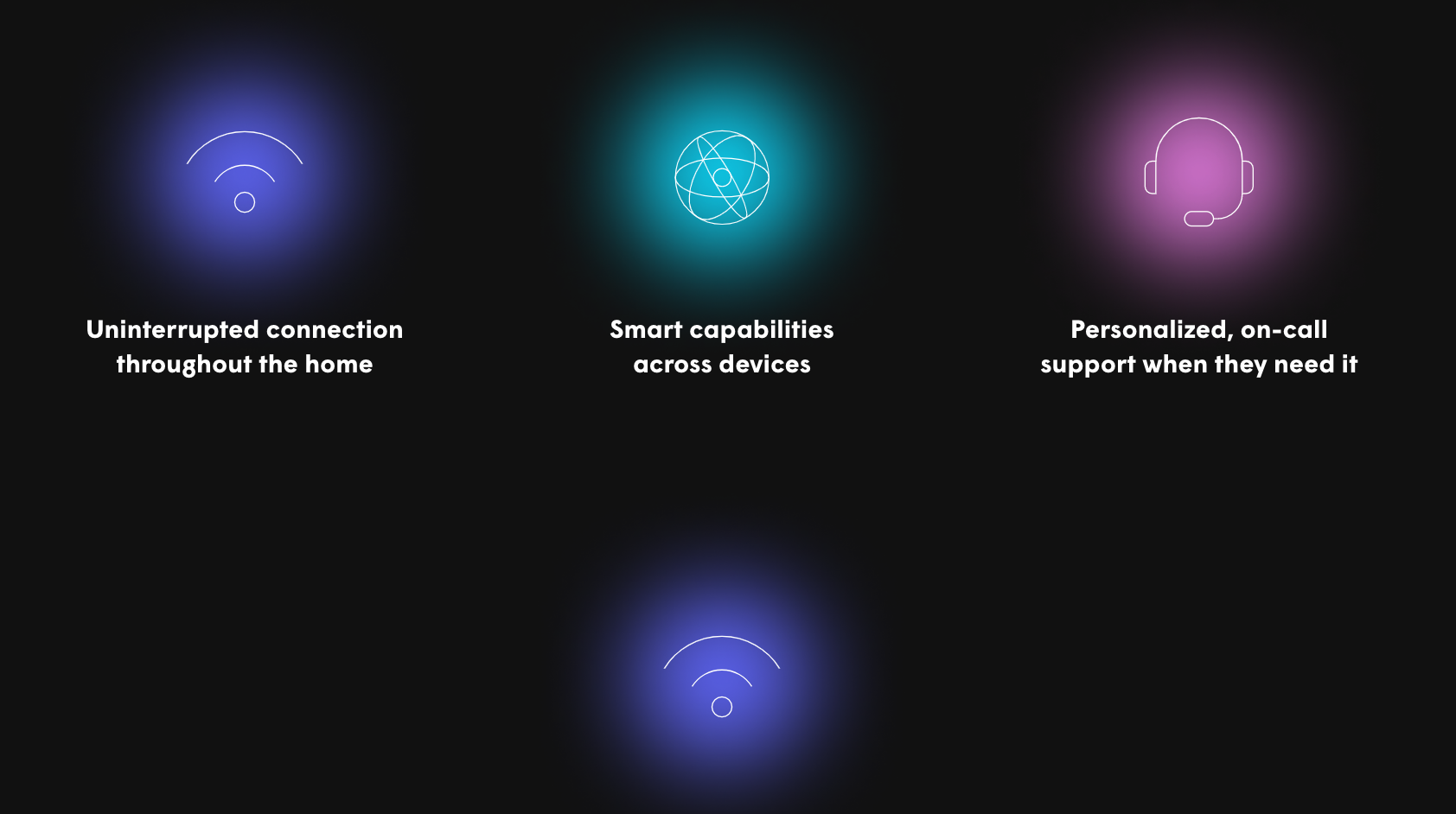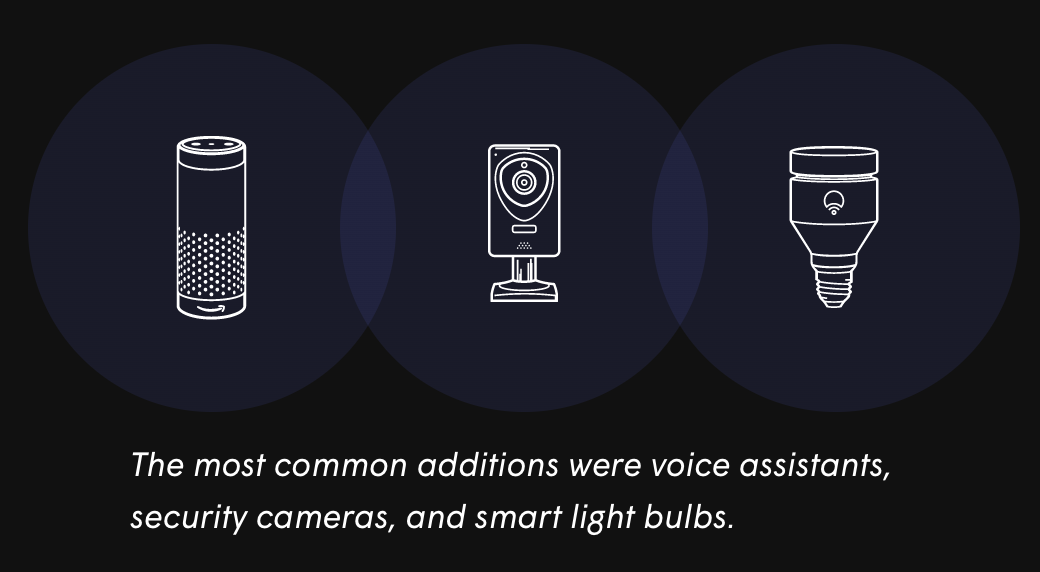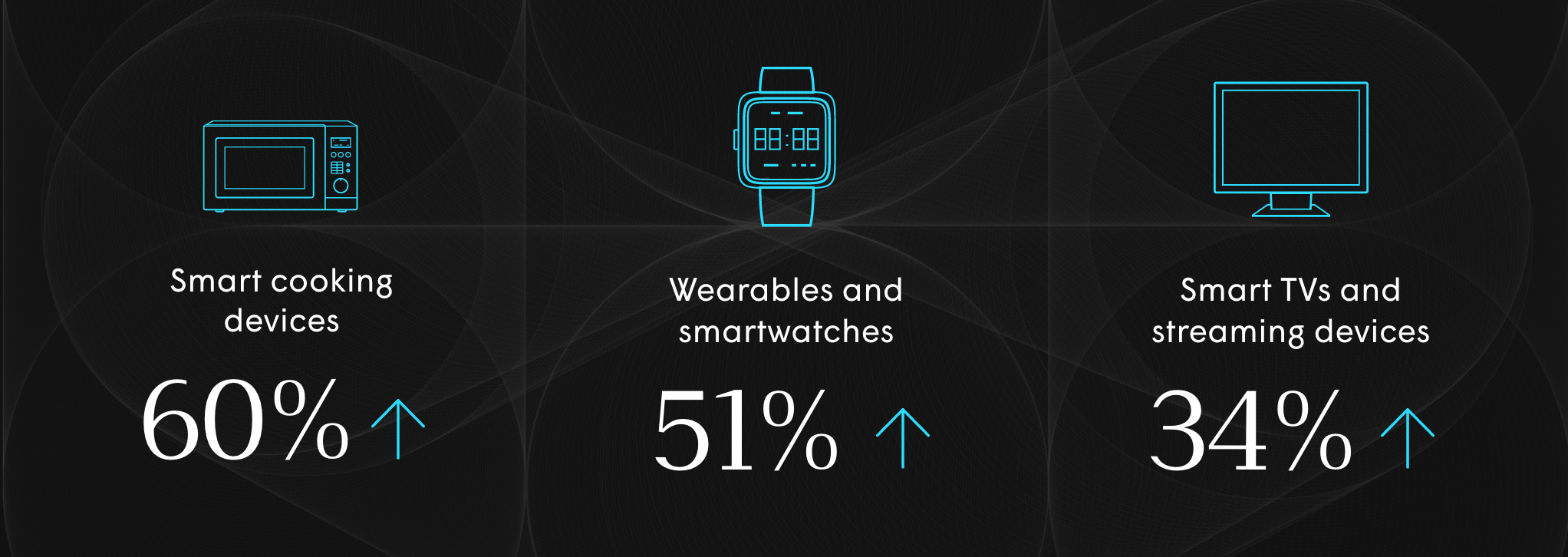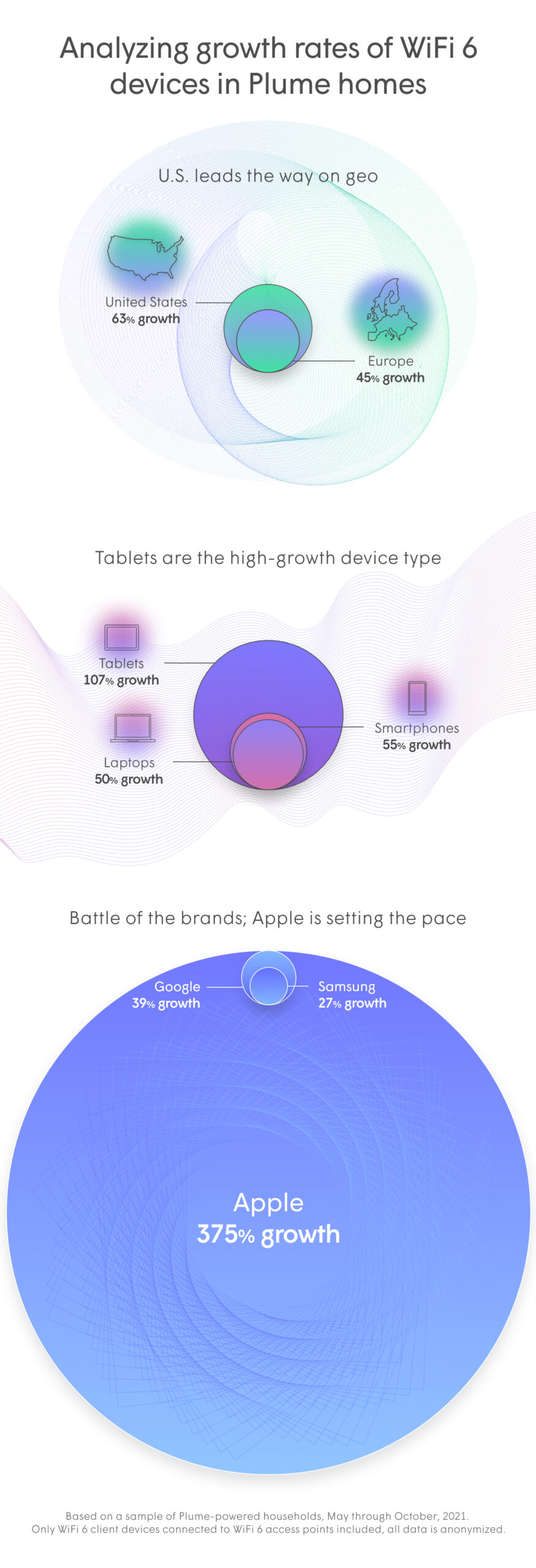Elon Musk’s SpaceX launched more than 1,000 satellites into orbit to test its internet service across the globe. And Amazon announced its plans to launch more than 3,200 satellites for its own service, Kuiper Systems.
But even with these corporations encroaching on their space, CSPs shouldn’t be ready to resign their market share just yet. With the right tools and strategies, they can better position themselves for longevity and secure a future-proofed spot as the comprehensive, go-to provider for their target customers. Additionally, President Biden recently signed a new executive order to increase regulation for big tech companies, which could open up competition in the space. So, here’s what CSPs need to know about the battle with big tech—and how to survive it.
CSPs still have the upper hand
Despite big tech’s big plans, CSPs still have a major advantage: They got here first. When people made that initial decision to bring connected devices and experiences into their homes, who did they turn to for help? CSPs. As a result, they’ve been using internet routers, cable boxes, and phone systems longer than they’ve been streaming Amazon shows and driving Teslas.

That means CSPs have an important opportunity to build on those relationships and offer even more value to their customers. And that’s why we think CSPs are actually in a great position—not only to keep their market share but also to gain more share in the digital space, which is currently going to big tech through their video and streaming platforms. They just need to know how to do it.
What CSPs can do to reclaim—and expand—their market
CSPs can use these key strategies to get ahead of big tech and maintain their positions as leaders in the broadband space.

Build a new bundle with additional services
CSPs already provide a broadband connection, but that’s no longer enough when they’re competing with big tech. They now need to offer additional services, such as:
As more people are working and learning from home, they need WiFi that works consistently— in every room and on any device. Beyond that, however, CSPs can offer WiFi that adapts to customer usage patterns and predicts where and when they’ll need coverage, so they’re never left buffering in a meeting or a class.

Essentially, CSPs need to build a new bundle—one that goes beyond just delivering internet, phone, and cable packages. With these new digital services, CSPs will be better positioned to compete with big tech and differentiate their offerings—and, of course, increase revenue. Also, remember that CSPs are uniquely positioned to deliver a new services bundle because they’re already in the home. Sure, Amazon is in the home, too, but only as a virtual assistant or a streaming platform. The CSP is still the customer’s gateway to a broadband connection and, thus, a more accessible portal to these new services.

Use a cloud-based system
While offering new smart services might sound overwhelming, CSPs don’t have to launch them all at once. Instead, they can make incremental changes by moving to a cloud-based system.
With this setup, CSPs can easily update customers’ firmware at scale, quickly launch new services, and gather real-time data about each user’s preferences and behaviors. From there, they can make better-informed decisions about what customers need and how to provide it.
Think about it. If you’re eager to launch a cyber-security service, for example, you don’t have to create an entirely new line of business or even deliver new hardware to your interested customers. You can use your cloud-based platform to gradually launch updates across your networks—making small changes to the systems you’ve already worked hard to put in place. So, where do you start? That’s where Plume comes in. Just like big tech companies, we grew up in the cloud. And we have the resources CSPs need to deliver more value to their customers at speed and scale. With the tools we have now—and the ones yet to come—we’re confident that CSPs will be well prepared to succeed in the battle with big tech. They just have to start now. You know, before any new satellites are launched.
“A strong HR organization is a core pillar and a critical function particularly for hyper-growth companies like Plume,” said Iman Abbasi. “Plume’s people-first culture, leadership, and commitment to thinking out-of-the box are what drew me here. I will focus on attracting, developing and retaining a diverse and global talent base, establishing and continuously tuning modern HR practices responsive to the new norms, and growing a solid people team as a key business partner to all of our leaders.”
“I was captivated by Plume’s vision and culture of innovation which, coupled with the opportunity to stand-up the company’s first in-house legal team, sold me on Plume,” said Shari Piré. “As Plume matures, it’s important that we build robust policies, practices, and procedures consistent with our unconditional commitment to compliance, privacy, and data security, as well as our ambitious environmental, social, and governance (ESG) goals, including sustainability, responsible resource utilization, and the #PlumeStrong initiative.”
“Plume’s proven track record of innovation, ‘think big culture’, and huge market opportunity drew me in,” said Kiran Edara. “With unique access to a massive set of proprietary data, core competence in drawing valuable insights, novel technology, and world-class engineering talent, Plume is ideally positioned to solve complex technical problems to deliver unparalleled levels of service personalization. I’m excited to lead and scale a multi-disciplinary, global engineering team.”
“We are thrilled to welcome Iman, Shari, and Kiran to Plume,” said Fahri Diner, Founder and CEO of Plume. “All three are incredibly talented individuals, exceptional leaders, and subject matter experts who will propel us to new heights.”
About Iman Abbasi
Abbasi most recently was Chief Human Resources Officer at Symbotic where she spearheaded the growth and scalability of the business through Talent Acquisition, Talent Development, Rewards, Benefits, Policies, Culture, and Employee Engagement. Prior to that, she was at LexisNexis Risk Solutions (NYSE: RELX), where she worked as VP of HR and before that, she was VP of HR at Thomson Reuters (NYSE: TRI).
About Shari Piré
Piré has been a trusted legal advisor for 20+ years, including at Skadden, Arps, Slate, Meagher & Flom LLP in New York City and Paris, along with Willkie Farr & Gallagher LLP, where she represented public and private companies and their owners on “bet-the-company” M&A transactions. Before Plume, Piré was Chief Legal Officer & Global Head of Sustainability at Cognate BioServices, a cell and gene therapy CDMO. Piré serves on the board of directors of Precision BioSciences, Inc. (NASDAQ: DTIL).
About Kiran Edara
Edara has more than 25 years of software development experience, including ten years at Amazon (NASDAQ: AMZN) and ten years at Motorola Mobility LLC, a Lenovo Company (OTC: LNVGY). He also holds over 60 granted patents. Most recently, Edara served as Director of Software Development/GM Connectivity Services, EC2 Edge at Amazon Web Services, Inc. (AWS). Prior to that, he held the roles of Senior Software Development Engineer, Software Development Manager, and Senior Software Development Manager at Amazon Lab126.
About Plume®
Plume® is the creator of the world’s first SaaS experience platform for Communications Service Providers (CSPs) and their subscribers, deployed in more than 41 million active locations globally. As the only open and hardware-independent, cloud-controlled solution, Plume enables the rapid delivery of new services for smart homes, small businesses, and beyond at massive scale. On the front end, Plume delivers self-optimizing adaptive WiFi, cyber-security, access and parental controls, and more. CSPs get robust data- and AI-driven back-end applications for unprecedented visibility, insights, support, operations, and marketing. Plume leverages OpenSync™, an open-source framework that comes pre-integrated and supported on the leading silicon, CPE, and platform SDKs.
Plume’s investors include Insight Partners, SoftBank, Liberty Global Ventures, Qualcomm and Samsung.
Visit plume.com, plume.com/homepass, plume.com/workpass, and opensync.io.
Follow Plume on LinkedIn and Twitter.
Plume and OpenSync are either trademarks or registered trademarks of Plume Design, Inc. Other company and product names are used for informational purposes only and may be trademarks of their respective owners.
“As a founder and entrepreneur, I not only look for great technology that customers love, and a talented team, but also the opportunity to create an entirely new category,” said Magdalena Yesil. “Plume has created a new category that is redefining consumer experiences in smart spaces, and I’m thrilled to be a part of this ambitious group of people.”
“Looking through the lens of cloud services and finance, I was very impressed with the high growth SaaS business Plume has built to date,” said Roxanne Oulman. “I am thrilled about the opportunity to collaborate closely with such a talented team, and look forward to rolling up my sleeves to help them hyper-scale across a number of vectors.”
“I’ve long shared Fahri’s vision, and appreciated Plume’s ambitions in reconstructing residential and small business service bundles,” said Tony Werner. “Today, over 95% of home devices, ranging from personal computers, e-readers and tablets to the exploding number of IoT hardware, connect to broadband over WiFi. The one thing they all have in common is the critical need for high performance, reliable and consistent connectivity over an unlicensed, wireless spectrum. Plume is revolutionizing connectivity and the smart home experience with an open platform, hardware agnostic approach. I am excited to continue partnering with Fahri, and help the Plume team achieve their goals in transforming smart spaces globally.”
These appointments come on the heels of Plume’s explosive growth over the last three years. Plume powers more than 40 million active residential and small business locations with its cloud hosted services through more than 275 Communication Service Providers (CSP) across the Americas, Europe and Japan. To help fuel the accelerating expansion of the global software defined network controlled by its cloud control plane currently managing more than 1.6 billion unique client devices, Plume raised $540 million over two rounds of funding in 2021 from Insight Partners and SoftBank Vision Fund 2.
“I couldn’t be more excited and honored to welcome Magdalena, Roxanne and Tony to Plume,” said Fahri Diner, Founder and CEO of Plume. “They each bring unique skill sets, professional networks, and valuable perspectives to help propel us to new heights.”
About Magdalena Yesil Yesil is the executive chair of Informed.IQ, a robotic process automation company. She also serves on the boards of SoFi (NASDAQ:SOFI), Smartsheet (NYSE:SMAR) and Zuora (NYSE:ZUO). She is the founder of Broadway Angels, an all-female group of angel investors, and the first investor and board member of Salesforce, where she served on the Board from formation to post IPO. Earlier in her career, Yesil founded three companies dedicated to commercializing Internet access, e-commerce infrastructure, and electronic payments, which led to an acquisition and two IPOs. She began her investing career at US Venture Partners and is the author of the bestselling book Power UP! How Smart Women Win in the New Economy. She is also one of the four women featured in NY Times best-selling author Julian Guthrie’s book Alpha Girls.
About Roxanne Oulman Oulman most recently served as Executive Vice President and CFO at Medallia, an Experience Management SaaS company. Oulman led Medallia’s IPO in 2019 which was publicly traded (NYSE: MDLA) until the purchase by Thoma Bravo for $6.4B in October of 2021. Prior to Medallia, Oulman was CFO and Executive Vice President at CallidusCloud (NASDAQ: CALD), a publicly traded $2.4B market cap SaaS company. Previously, Roxanne led as the interim Chief Financial Officer at Thoratec Corporation (NASDAQ: THOR), a publicly traded medical device company, where she held multiple financial leadership roles from 2004 to 2013. Oulman is also the Audit Committee Chair of CalAmp (NASDAQ: CAMP) a Telematics company and has served on the board since July 2018.
About Tony Werner Werner served as CTO and then President, Technology, Product, Xperience at Comcast Cable. Prior to Comcast, Tony served as Senior Vice President and Chief Technology Officer for Liberty Global, Inc., in Englewood, CO, where he led the company’s global strategy for video, voice and data services. He has more than 40 years of engineering and technical management experience, having also held senior management positions with Qwest Communications, Aurora Networks, Tele-Communications, Inc. (TCI)/AT&T Broadband, Rogers Communications, Inc., and RCA Cablevision Systems.
About Plume® Plume® is the creator of the world’s first SaaS experience platform for Communications Service Providers (CSPs) and their subscribers, deployed in more than 40 million active locations globally. As the only open and hardware-independent, cloud-controlled solution, Plume enables the rapid delivery of new services for smart homes, small businesses, and beyond at massive scale. On the front end, Plume delivers self-optimizing adaptive WiFi, cyber-security, access and parental controls, and more. CSPs get robust data- and AI-driven back-end applications for unprecedented visibility, insights, support, operations, and marketing. Plume leverages OpenSync™, an open-source framework that comes pre-integrated and supported on the leading silicon, CPE, and platform SDKs.
Plume’s investors include Insight Partners, SoftBank, Liberty Global Ventures, Qualcomm and Samsung.
Visit plume.com, plume.com/homepass, plume.com/workpass, and opensync.io. Follow Plume on LinkedIn and Twitter.
Plume and OpenSync are either trademarks or registered trademarks of Plume Design, Inc. Other company and product names are used for informational purposes only and may be trademarks of their respective owners.
Learn how this leading telecommunications operator used Plume’s intelligent cloud-based platform to generate new revenue and achieve an impressive customer penetration rate of 25% with new smart home offerings.
Post-COVID life—the way consumers live, learn, work, and play—is unlikely to ever return to the old “normal.” For example, international consulting firm Telecom Advisory Services estimates that 54% of the workforce will be hybrid, working from home at least part of the time. The pandemic also accelerated digital transformation for many businesses, and consumers will not be giving up on the newfound digital experiences that resulted from that transformation.
These tech trends are taking hold just as WiFi 6 builds momentum in the market. Capable of supporting more advanced, bandwidth-intensive use cases such as virtual reality (VR) and augmented reality (AR), WiFi 6 is expected to bring drastic changes, both for consumers and enterprises. While this is exciting, it also presents a challenge for CSPs because they need to ensure their service delivery can support these use cases without adversely affecting the quality of experience for subscribers.
The pandemic already began altering the WiFi connectivity landscape. But the combination of three factors—the changing consumer behaviors, WiFi 6 adoption, and the expectation that regulators will allocate more WiFi spectrum—has the potential to elevate the role of WiFi to levels never seen before. And CSPs need to be ready.
Capable of supporting more advanced, bandwidth-intensive use cases such as virtual reality (VR) and augmented reality (AR), WiFi 6 is expected to bring drastic changes, both for consumers and enterprises.
The combination of these three factors has the potential to elevate the role of WiFi to levels never seen before
WiFi-powered innovation and future tech trends
Some of the potential of the new WiFi technology hinges on access to the 1200 MHz and 6 GHz band (WiFi 6E). Many countries have already made great strides in that direction. The US, for example, approved the 6 GHz spectrum to unlicensed WiFi in April 2020 (in what some have called a historic and monumental decision)—and by December 2020, FCC had already authorized the first WiFi 6E device.
April 2020
The US approved the 6 GHz spectrum to unlicensed WiFi
December 2020
FCC authorized the first WiFi 6E device
While these developments are still in the early stages, the 6 GHz spectrum and future WiFi generations will deliver another wave of AR/VR innovation, IoT expansion, increase in video streaming, and more.
One trend that CSPs should be preparing for right now is the self-optimizing, adaptive home of the future. Simply having smart home conveniences is no longer satisfying for consumers. In the near future, consumers of all ages will be expecting a truly smart home—one that learns from their living patterns and behaviors and adapts to their lifestyles.
As another example, consider the metaverse, one of the hottest ideas that’s making its way from enthusiastic consumer discussions into the business space. A virtual world that mixes digital technologies like VR, videoconferencing, gaming, live-streaming, cryptocurrency, and others, the metaverse is only a fantasy at the moment. What stops it from moving forward is, in large part, the lack of superfast, low-latency connectivity.
If the metaverse does take a leap forward as WiFi speeds and reliability improve, it has the potential to bring millions of people together into a digital world that they can access from anywhere, and not just to play. Shopping, team meetings, concerts—the potential for experiences is unlimited, which explains why technology giants like Facebook and Microsoft want to move the concept of the metaverse forward. The commercial potential is huge.
While this idea is years—and leaps and bounds—away, it’s an illustration of what’s to come. Our future will become more and more connected, and WiFi’s social and economic benefits will grow exponentially.
Benefiting from the digital economy boom
CSPs can take advantage of all these exciting developments by delivering new services to subscribers, such as smart home and IoT services. As all the new WiFi-powered innovation makes it into customers’ homes, managed WiFi will also see high demand. Already, people want to take better control of their home WiFi experience—and this will increasingly become an expectation as their connectivity needs evolve.
But the old business models weren’t designed for these kinds of opportunities. With competition in the space fiercer than ever, only CSPs that are agile and innovative will succeed. Traditional solutions that are based on hardware simply can’t keep up with the fast-paced changes in the digital economy. And they don’t scale to the level that these changes require.
For an industry that’s so critical to digital resilience and to the economy, CSPs have been surprisingly slow to transform. For example, the cloud, among other technologies, has long been driving transformation across numerous sectors, yet CSPs are only just now realizing its transformative potential.
Unlike service delivery that’s based on hardware and software, the cloud enables fast time to market and the ability to roll out services quickly to millions of customers. And that’s just for starters.
With cloud-based service delivery platforms, CSPs can continuously add new services with simple software coding, drastically cutting costs.
What’s next?
Whether the connected future brings us exciting new adventures like the metaverse or simply better digital experiences with the technologies we already have, CSPs can’t afford to sit on the sidelines.
Other WiFi industry players are moving fast to benefit from the digital boom—it’s time for CSPs to do the same. They need to implement forward-thinking ideas and lead some of the innovation instead of trying to catch up with it.
Plume’s cloud-based service-delivery platform can help CSPs to benefit from the changing connectivity landscape and next-generation WiFi trends.
Learn how to take advantage of the agility and scalability of the cloud, combined with Plume’s interoperable, hardware- and vendor-agnostic platform.
Smart home devices aren’t just getting more popular. They’re also creating new customer expectations and transforming the way people work, relax, and learn in their homes.
“Thanks, in part, to COVID-19, things have changed dramatically,” Plume CCO Tyson Marian said in a recent webinar. “[Customer] expectations have increased because their entire livelihood really rests on the quality of experience in the home. And we don’t see that changing anytime soon.” Communications service providers (CSPs) must keep up with these changes or risk getting left behind. And that means using data to understand exactly what customers want from their smart home experiences and how you can deliver it.
“The smart home today is less about the devices in your home and more about the data that those devices produce to create cross-device experiences. That’s why the smart home is really starting to take off now and why we believe it will continue to grow.”
Tyson Marian, Plume CCO

Uninterrupted connection throughout the home
There are more connected devices in the home than ever—and the pandemic just sped up adoption. As more people had to quarantine and begin working and schooling from their residences, what did they invest in? Smart home devices.
In a recent study, Plume found that the number of devices per U.S. household increased 38% from October 2019 to May 2021—the most common additions being voice assistants, security cameras, and smart light bulbs.
 38% The number of devices per U.S. household increased 38% from October 2019 to May 2021
38% The number of devices per U.S. household increased 38% from October 2019 to May 2021
 With all of their smart devices, customers expect seamless, uninterrupted connection so they never have to miss a meeting, class, or a favorite TV show. And if they’re now paying for more hardware and software than they used to, they want to know that they’re getting their money’s worth.
With all of their smart devices, customers expect seamless, uninterrupted connection so they never have to miss a meeting, class, or a favorite TV show. And if they’re now paying for more hardware and software than they used to, they want to know that they’re getting their money’s worth.
“Our digital life is becoming the greatest cost in our life outside of possibly a mortgage. What the customer expects is that those [devices and platforms] work and that they always work.”
Tyson Marian, Plume CCO
Smart capabilities across devices
In a world of smart technology, a watch is no longer just a watch and a bike is no longer just a bike. Instead, they’re internet-connected devices that use data to learn about your needs and deliver automated, personalized experiences. And consumers have increasingly come to expect those features.
“If I get a new thermostat, it’s got to give me more than just the ability to adjust the controls. With sensorless motion detection, for instance, Plume can actually turn devices like a smart thermostat into a sensor. This is the sort of thing that turns an otherwise simple thermostat into something more useful, and turns a home into a smart home.”
Tyson Marian, Plume CCO
During the pandemic, investments in smart cooking devices grew 60%, wearables and smartwatches 51%, and smart TVs and streaming devices 34%.
Personalized, on-call support when they need it
With all of these connected devices, CSPs should be able to gather real-time data about their customers’ experiences and offer personalized, proactive support as needed.

“When they actually call the service provider with an issue, the customer wants you to know who they are. They also want you to be able to help solve their problem efficiently.”
Tyson Marian, Plume CCO
Marian recalled a support call he once heard where a customer was passed from representative to representative until someone was able to finally address the problem. And for each new person, the customer had to repeat their name, account number, and issue. A CSP with a cloud-based, data-driven system would have been able to get a bird’s-eye view of the devices in the customer’s home, easily connect those that weren’t on the network, and offer a customized solution for increased coverage—all in just a few minutes. “That’s the kind of experience that the customer wants: bespoke,” Marian said. “What’s going on in my house and can you offer me a solution?” As smart home devices become more ubiquitous and customers less tolerant of unpersonalized experiences, CSPs have to step up their game and find a way to become a one-stop shop for customers’ evolving needs and preferences.
“A lot has changed; a lot is going to continue to change. And our belief is that every change will present more data, which means more opportunities to create new digital, smart home experiences.”
Tyson Marian Plume CCO
Welcome to Plume IQ, our monthly reveal of data-driven intelligence and customer-focused insights from more than 1.2 billion connected devices managed in the Plume Cloud.
What’s driving WiFi 6 device deployments?
WiFi 6 arrived to a wave of excitement, promising increased throughput, improved latency, power savings and enhanced security, all maximized when paired with cloud-control. Two-years following the arrival of the first devices, we dipped into data from the Plume Cloud to look at the latest deployment growth rates:

Communications service providers (CSPs) used to rest easy knowing they were equipped to meet their customers’ needs. Want a cable package? They’ve got it. Ready to bundle your phone and internet services? Easy. Eager to record your favorite shows? There’s a device for that.
Today, customer behaviors—and needs—have changed in ways only a few imagined just a decade ago. As people connect more devices to their home networks and rely on those networks more often for remote work and study, customers are demanding higher quality from their digital, in-home experiences. As a result, CSPs are under increased pressure to provide more value and keep up with an ever-changing market. Meaning, they’re facing some sleepless nights with few sheep in sight. The good news is that it doesn’t have to be that way. In a recent interview with Intelligent Briefings about how smart home experiences have evolved, Plume CCO Tyson Marian broke down some of toughest challenges CSPs are facing and the solutions they need to future-proof their businesses—no matter how often customer expectations may shift.
Lack of agility
One of the toughest challenges facing many legacy CSPs is their inability to adapt quickly to changing customer preferences. They spend so much effort making the sale and getting hardware into people’s homes, but once they do, updating that hardware is a chore—or, worse, not even an option. So when customers inevitably want to expand or upgrade their services, their CSP isn’t equipped to meet their needs and those customers go elsewhere.
SOLUTION
Cloud-based networks that automatically adapt
Enter: the cloud. By setting up cloud-based networks, CSPs can easily update their customers’ software and adapt to meet expectations. This way, they don’t have to waste precious time and resources switching out the hardware or building new services from scratch. “The cloud services that we deliver allow the CSP to immediately turn on new services at the snap of their fingers, so they can get to more people at a very fast pace,” Marian said. “Our belief is that it will no longer be about the speed of the network but about the speed at which you can deliver new services. And that can only happen if you’re delivering those services from the cloud.”
“Our belief is that it will no longer be about the speed of the network but about the speed at which you can deliver new services.”
Tyson Marian, Plume CCO
Frustrated customers who need support
No customer wants to spend hours on hold, jumping between customer- and tech-support representatives just to find out why they don’t have service. Unfortunately, that’s still the reality for many subscribers.
SOLUTION
Systems that predict issues before they happen
CSPs can prevent these frustrations by using data and technology to anticipate—and address—issues before they occur. Take, for example, Signal by Plume, which uses AI to monitor WiFi speed and connection across devices in customers’ homes. Once it spots a potential issue, Signal alerts CSP support teams before the customer is affected. From there, the CSP can proactively reach out to the customer with a ready-made solution or use their software to solve the issue remotely. During the pandemic, Plume saw that many customers were using more WiFi to take calls on Zoom and Microsoft Teams. The system immediately sent targeted emails to those customers that said, “Working from home? Upgrade now from 50 to 75Mbps speeds for an extra $10 a month.”
“That’s how you can turn what was a symptom and a problem into incremental revenue. All of that is 100% data-driven.”
Tyson Marian, Plume CCO
Decreasing market share
Due to the obstacles above, CSPs are losing market share to more agile competitors. Just look at big tech companies like Amazon that are swooping in to deliver advanced broadband and video services. If CSPs want a chance at competing and surviving, they need to adapt not just to win new customers but to retain the customers they already have.
SOLUTION
Partners to help boost customer retention
When Plume is delivered through a single access point in customers’ homes, CSPs have seen customer churn decrease by as much as 30%. When those CSPs add Plume coverage options like WiFi pods and extenders, churn can drop by another 30%. That amounts to major increased revenue. As Marian pointed out, a lost customer can cost CSPs more than $1,000. And then acquiring a new customer to replace them can cost another $400.
“If you can keep a subscriber in our industry for an additional two years, about $1,700 goes to your bottom line. Those are pretty big savings for our CSP customers.”
Tyson Marian, Plume CCO

In today’s home security landscape, hackers are the new cat burglars. It’s no surprise: Economists argue that data is now the world’s most coveted resource—beating out oil, gold, and other valuable materials.
That means homeowners need to protect their data as fiercely as they safeguard their prized possessions. The problem is, keeping information secure is a lot more complicated than locking diamonds in a safe.
The fact that most homes today have many devices—each one a possible access point for hackers—makes cyber-security even more challenging. The average Plume home, for instance has, on average, 14.5 connected devices spanning multiple smartphones, work-issued laptops and tablets, video game consoles, IoT devices, and more.
Read our entire whitepaper to learn more about the role that CSPs can play in keeping home networks as secure as possible. Download here
— Deutsche Glasfaser—Germany’s leading FTTH service provider—and BREKO eG—Germany’s premier broadband association—turn to Plume for next-generation subscriber experiences—
PALO ALTO, Calif., June 10, 2021 /PRNewswire/ — Personalized smart services pioneer Plume® today announced that it has reached agreement on two major new partnerships that cement its presence in the German region. Deutsche Glasfaser Group—the leading fiber-optic service provider in rural Germany—will launch a new bundle of digital subscriber experiences to its residential broadband customers. Additionally, Plume has entered into a cooperation with BREKO eG—the commercial platform of Bundesverband Breitbandkommunikation e.V. and leading broadband association in Germany—to make Plume’s platform and services also available to over 200 member Communications Service Providers (CSPs).
Central to the Deutsche Glasfaser partnership is the implementation of Plume’s cloud- and AI-driven SaaS experience management platform which leverages OpenSync™ and features HomePass™—a next-generation front-end Smart Home Services suite—and Haystack™—intelligent back-end support tools and data analytics. The platform will enable Deutsche Glasfaser to expand its product portfolio with highly personalized service offerings which extend the customer experience throughout subscribers’ homes. The OpenSync open-source framework gives Deutsche Glasfaser access to a flexible and cloud-agnostic architecture to enable rapid service curation, delivery, scale, management and support of Plume’s digital subscriber services.
In leveraging HomePass, Deutsche Glasfaser will build on the super-fast broadband speeds enabled by its fiber-optic broadband network, to bring customers a host of experience-driven benefits including flawless WiFi connectivity, AI-driven cybersecurity and IoT device protection, sophisticated parental supervision, secure access controls, motion awareness, and more. In addition, Haystack incorporates real-time and predictive customer support tools, enabling Deutsche Glasfaser to assist residential subscribers proactively with support requests. Haystack is field-proven1 to increase customer satisfaction and drive significant reductions in support calls and truck rolls.
“We are thrilled to partner with Deutsche Glasfaser, one of the fastest growing FTTH providers in Germany—they have made an astute decision in selecting Plume’s highly scalable cloud-driven experience management platform that will support their growth plans,” said Tyson Marian, Chief Commercial Officer, Plume. “While fiber supports the delivery of incredibly fast speeds to the home, it is Plume’s objective to enable providers to further enhance customer experience by providing a new bundle of smart home services that increase customer satisfaction and loyalty.”
Commenting on the partnership, Ruben Queimano, Chief Commercial Officer, Deutsche Glasfaser, said: “As a pioneer and pacesetter in the industry and the leading fiber-optic provider for rural areas in Germany, we have already deployed one million FTTH connections and we will accelerate our growth in the future. The partnership with Plume—also a pioneer in their field—will help us to deliver the best internet experience to our customers, complementing a high-speed internet connection with a premium smart home experience. This includes the provision of a fully optimized and flawless WiFi experience delivered to every device.”
Through BREKO eG’s new partnership with Plume, cooperative CSP members have the opportunity to launch Plume’s SaaS experience management platform––including smart home and intelligent business suites––with special pre-agreed terms. Plume’s cloud-based approach and seamless integration with back-end systems accelerate go-to-market, enabling service providers to be up-and-running in less than 45 days. The partnership means that BREKO eG’s growing number of alternative fixed broadband operators will have access to Plume’s solution to increase ARPU and reduce OpEx by optimizing the in-home broadband experience.
“We look forward to working closely with the Plume team. With this cooperation, we can help our network operators understand and implement adaptive WiFi services to substantially improve the in-home experience for their subscribers,” said Jürgen Magull, Managing Director of BREKO eG. “Since it can be assumed that the work-from-home era will continue indefinitely, flawless connectivity and robust cybersecurity are high on the agenda of consumers, businesses and the service providers who serve them—our members can only benefit from the potential of satisfied customers along with increasing ARPU while reducing OpEx and lowering churn.”
About Deutsche Glasfaser
The company plans, builds and operates fiber optic direct connections for private households and companies. Deutsche Glasfaser is a key driver to expand the nationwide broadband coverage in rural areas. With innovative planning and construction methods, Deutsche Glasfaser implements FTTH network connections quickly and cost-efficiently in close cooperation with the municipalities – also within the framework of existing funding programs for nationwide broadband expansion. In 2020, the experienced fiber optic investors EQT and OMERS founded the company through a merger of the network providers inexio and Deutsche Glasfaser. With the largest number of customers, Deutsche Glasfaser is the market leader among FTTH providers in Germany. www.deutsche-glasfaser.de
About BREKO Einkaufsgemeinschaft eG
As the leading fiber optic association with more than 380 member companies, the Bundesverband Breitbandkommunikation e.V. (BREKO) successfully promotes competition in the German telecommunications market. Its members are clearly committed to future-proof fiber optics and are currently responsible for almost 75 percent of the competitive expansion of fiber optic connections to buildings and homes. As a strong partner for member companies of the Bundesverband Breitbandkommunikation e.V., BREKO Einkaufsgemeinschaft eG was founded as a cooperative in 2010 to offer all network operators and municipal utilities a commercial platform and to create economic added value in fiber optic expansion. As an aggregator, multiplier and facilitator, the BREKO Einkaufsgemeinschaft ensures an attractive and extensive product portfolio, which a large number of member companies use for fiber roll-out in order to strengthen their competitiveness in the long term. www.breko-einkaufsgemeinschaft.de
About Plume
Plume® is the creator of the world’s first SaaS experience platform for Communications Service Providers (CSPs) and their subscribers, deployed in more than 25 million locations globally. As the only open and hardware-independent solution, Plume enables the rapid delivery of new services for connected homes, small businesses, and beyond at massive scale. On the front end, Plume delivers self-optimizing WiFi, cyber-security, access controls, and more. CSPs get robust back-end applications for unprecedented visibility and support. Plume leverages OpenSync™, an open-source framework which comes pre-integrated and supported on the leading silicon, CPE, and platform SDKs.
Visit plume.com, plume.com/homepass, plume.com/workpass, and opensync.io.
Follow Plume on LinkedIn and Twitter.
Plume, HomePass, Haystack and OpenSync are either trademarks or registered trademarks of Plume Design, Inc.
1 Source: Total Cost of Ownership Study, Plume, 2020
Logo – https://mma.prnewswire.com/media/1477960/Plume_symbol_wordmark_row_dark_bg_Logo.jpg

SOURCE Plume Design, Inc.